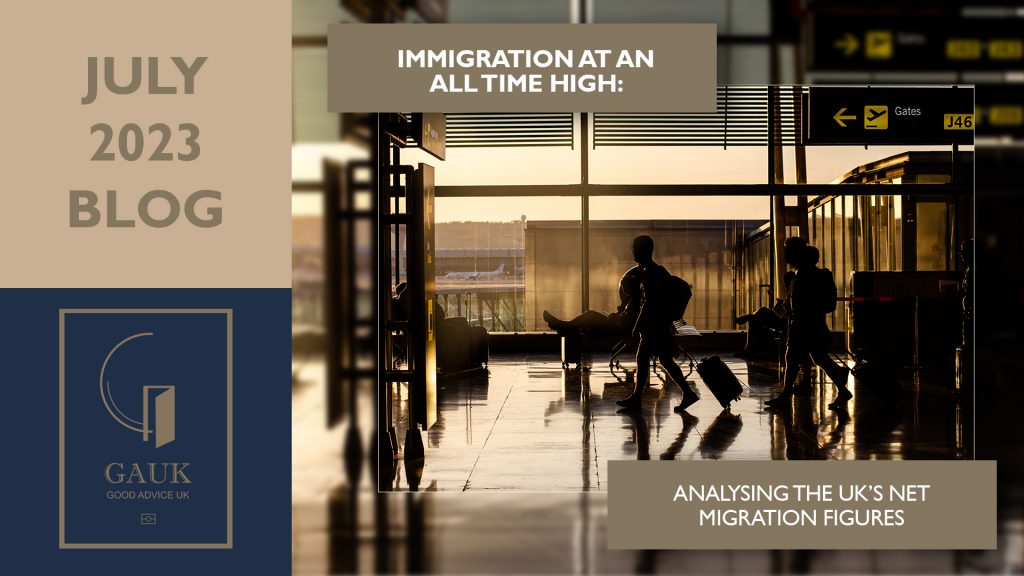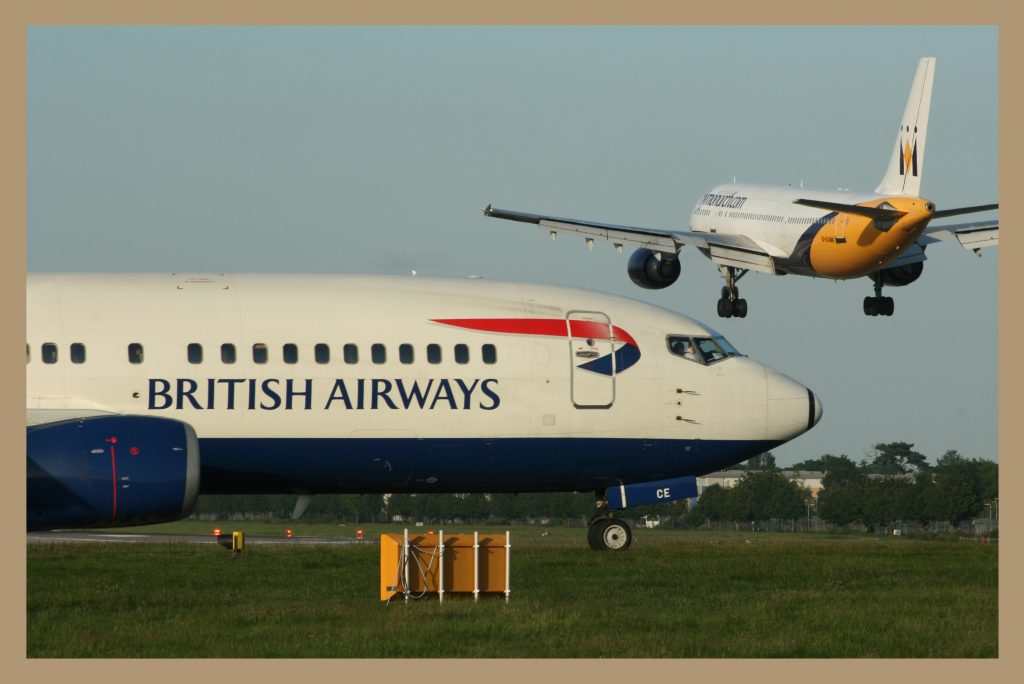
On 25 May 2023, it was announced that net migration to the UK for 2022 was 606,000 new arrivals. This was a record for the UK, an increase of over 100,000 from the previous year and almost double that of 2018. It should be noted that these figures do not include those arriving on short-term visas, so tourists, masters’ students, etc. are not included in these statistics. Furthermore, this is not the total number of arrivals, which is much higher: 606,000 more people arrived in the UK than left in 2022. While high, the numbers are lower than anticipated, with some predicting net migration of 700,000 or more.
In this post, we will examine the numbers, what is behind the increase, what kind of visas are being granted, where people are coming from, whether these numbers are likely to continue and what this means for potential future visa applicants.
First, though, we briefly look at the history of net migration to the UK. After the end of the Second World War, there was a large growth in the number of people entering Britain from overseas. Most of them travelled from British colonies or former colonies in Africa, the Caribbean and Southeast Asia. At the same time, large numbers of people left the UK, with most settling in Australia, New Zealand, Canada and the United States of America. This meant that from the late 1940s until the early 1990s, the UK had net emigration, with more people leaving the country than entering. This began to change in the late 1990s and really picked up steam in the 2000s with the growth in immigration from the EU. Although the UK had joined the EEC (the forerunner to the EU) in 1973, it was not until the expansion of the EU in 2004 that migration from EU countries to the UK really took off. While the number of people leaving the UK remained roughly the same, the number of people from EU countries exercising their right to freedom of movement by settling in the UK meant that the UK’s net migration numbers became positive rather than negative as more people entered the UK than left it.

Scottish emigrants on board the Minnedosa, headed towards Canada

British migration to Australia
In 2022, the total number of long-term new arrivals (those granted visas lasting a year or more) was 1.2 million, while total emigration was 557,000. Most of those coming to the UK were non-EU nationals (925,000), with EU and British nationals making up the rest (151,000 and 88,000, respectively). The ratio was less drastic among those emigrating, with 263,000 non-EU nationals leaving compared to 202,000 EU nationals and 92,000 British nationals. This shows that more EU and British nationals are leaving the UK than entering, with non-EU migration the main driver of the increase.
There is no single cause for the increase in net migration. A significant factor, however, has been the opening of humanitarian routes for people from Ukraine and Hong Kong. Of the 172,000 people who came to the UK via humanitarian routes in 2022, 169,000 of them arrived under the Ukraine visa schemes, while 52,000 of the 88,000 British nationals entering the UK in 2022 are holders of British National (Overseas) (BN(O)) status (a form of British nationality unique to Hong Kong), and most entered using the bespoke BN(O) visa route. When combined with 76,000 non-EU asylum claimants who entered the UK in 2022, these figures mean that people using humanitarian routes accounted for roughly a quarter of non-EU migration, a much higher percentage of non-EU arrivals than in previous years.

2022 also saw massive growth in the number of people coming to the UK to work, with 235,000 people from outside the EU entering the UK with work visas in 2022, compared to 137,000 in 2021 and 70,000 in 2020. This is supplemented by 62,000 EU nationals and 19,000 British nationals granted work visas, bringing the total to 316,000 UK work visas granted in 2022.
This large number of work visas can be explained mainly by the surge in overseas recruitment for people to work in the NHS and the social care sector. Since 2020, there has been a bespoke visa for those seeking to work in the NHS or social care, and in 2022 over 238,000 people entered the UK on one of these visas, more than all other working visas put together. By contrast, the number of Skilled Worker visas granted to people working in other sectors, such as finance and IT, actually decreased in 2022 compared to previous years. This trend has yet to peak, with over 100,000 NHS and social care worker visas already issued in the first quarter of 2023.

The largest number of visas were granted to students, with 361,000 study visas granted to people from outside the EU and 404,000 granted in total. While people with study visas represented the largest proportion of non-EU arrivals in the UK and increased from 2021, their share in net migration fell, with people coming to the UK for study constituting 39% of overall arrivals. This is a decrease from 2021, where they represented 47% of overall arrivals. Additionally, while the number of study visas issued to non-EU nationals increased, it decreased for EU and British nationals.

Despite the significant increase in the number of Ukrainians entering the UK in 2022, India was the number one recipient of UK visas in 2022, with over 343,000 visas issued to Indian nationals in the last year. Nearly a third of study visas and over a third of work visas were issued to Indian nationals, with the only category of long-term visas where India was not number one being family visas (Pakistan was first in that category). The five countries with the highest number of people granted study visas were India, Nigeria, China, Pakistan and Bangladesh, while the top five for work visas were India, Nigeria, Zimbabwe, the Philippines and Pakistan.
That is not to say that immigration at this high level will be permanent. Unique events like the war in Ukraine and the situation in Hong Kong are unique and may not be replicated for future humanitarian crises. Additionally, while the government is keen to attract more students to come to UK universities, the new restrictions on dependents that those with student visas can bring to the UK may lead to a decrease in people applying for study visas. This is part of the government’s broader attempts to reduce immigration to the UK. While their ability to do so is not unconditional (for example, although the UK government broadly opposes crackdowns on protesters or attempts to reshape the world’s borders by force, neither of these are things they can control), they can still introduce additional hurdles to making a successful application.
One of the reasons the government is doing so is for political reasons. Broadly speaking, the history of UK immigration policy is of periods of relative openness followed by a backlash that leads to more restrictions. The arrival of refugees from what was then the Russian Empire in the 19th century was followed by the restrictions of the Aliens Act 1905. The arrival of people from British colonies in the decades after the Second World War led to a series of laws restricting their right to enter the UK. The expansion of the EU in the 1990s and 2000s, and the consequent increase of people exercising their right to freedom of movement within the EU by coming to the UK, led to Brexit.
There are, however, indications that this cycle might be breaking. Despite the levels of net migration going up since Brexit, polling data shows that opposition to increasing immigration is declining and becoming less of an important issue to UK voters. To the extent that British people are worried about immigration, their anxiety is directed towards those who enter unlawfully, not those with valid entry clearance.
There are many theories for why this may be. One is that the end of freedom of movement post-Brexit has placated many of those anxieties and that the issue was the lack of restrictions, not the number of new arrivals. It has also been attributed to the fact that, as time goes by, the percentage of the population that has grown up with multiculturalism being a normal aspect of life in the UK, and is therefore comfortable with rising immigration, has increased and now outnumber those who oppose change. This also leads to a third aspect, familiarity. In the aforementioned periods of openness, the new arrivals arrived from countries with which most British people were unfamiliar. This led to significant cultural changes, as new food became available in shops, new languages were spoken in public spaces, new religious buildings were built, and so on.
This is different in 2023. As was shown before, the largest number of new arrivals in 2022 came from India. People have been migrating to the UK from India for the best part of 300 years. People of Indian descent have made up a significant percentage of the UK’s population for over 50 years. Curry has been a staple of British cuisine for decades. The UK’s current Prime Minister, Rishi Sunak, is the son of Indian immigrants. In other words, people coming to the UK from India is not new and is something with which most people in the UK are more than comfortable. Decades of immigration from Africa, the Caribbean, the Indian subcontinent and continental Europe means most students and workers entering the UK come from countries that have longstanding ties to the UK and existing communal networks in the UK, meaning they fit well into the status quo.
The challenges faced by people arriving from Ukraine are slightly more complicated, as their presence in the UK is more recent. This is mitigated, however, by the fact that the Ukrainian cause is very popular, and the majority of the population welcomes their presence in the UK.
All this means that despite Brexit and political rhetoric, it is likely that the UK will remain a country that accepts high levels of immigration and will continue to grant visas in large numbers to those who seek to work or study in the UK. While net migration will not always continue to grow and may not remain at its current levels due to the unique circumstances of many arrivals, it nonetheless is likely to stay high, and the UK’s appetite for new arrivals will not diminish for the foreseeable future.
Should you need guidance pertaining to your Individual, Business or Humanitarian UK immigration matter,
To arrange meeting with our lawyers, contact us by telephone at
+44 2077202156 or by email at office@goodadviceuk.com.
If you have instructed us before, we would be pleased to know your feedback about your experience.
| Cookie | Duration | Description |
|---|---|---|
| cookielawinfo-checbox-analytics | 11 months | This cookie is set by GDPR Cookie Consent plugin. The cookie is used to store the user consent for the cookies in the category "Analytics". |
| cookielawinfo-checbox-functional | 11 months | The cookie is set by GDPR cookie consent to record the user consent for the cookies in the category "Functional". |
| cookielawinfo-checbox-others | 11 months | This cookie is set by GDPR Cookie Consent plugin. The cookie is used to store the user consent for the cookies in the category "Other. |
| cookielawinfo-checkbox-necessary | 11 months | This cookie is set by GDPR Cookie Consent plugin. The cookies is used to store the user consent for the cookies in the category "Necessary". |
| cookielawinfo-checkbox-performance | 11 months | This cookie is set by GDPR Cookie Consent plugin. The cookie is used to store the user consent for the cookies in the category "Performance". |
| viewed_cookie_policy | 11 months | The cookie is set by the GDPR Cookie Consent plugin and is used to store whether or not user has consented to the use of cookies. It does not store any personal data. |